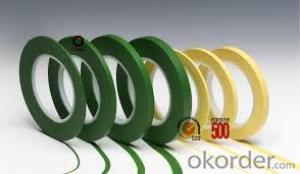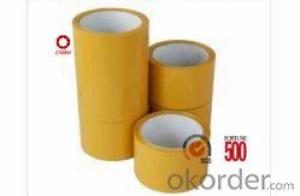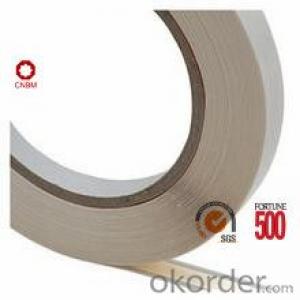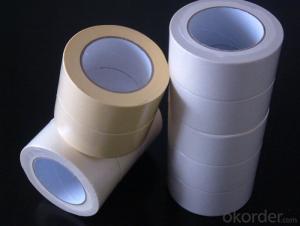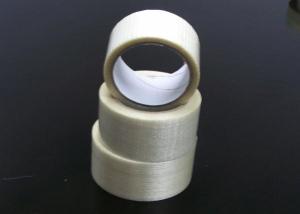Wholesale Box Packaging Tape with Can Tear Paper Sticky Hairs Cleaning Tape
- Loading Port:
- China main port
- Payment Terms:
- TT OR LC
- Min Order Qty:
- 10000 roll
- Supply Capability:
- 10000000 roll/month
OKorder Service Pledge
OKorder Financial Service
You Might Also Like
Specification
1.Used for wiping off hair,dust and scurf
2.Very small exquisite and easy to carry
3.Non-poisonous and odorless
4.Refillable
Features
Sticky Cleaning Lint Roller (refill ,remover)
Used for wiping off hair, dust and scurf on clothes, cars, sofas, blankets, curtains and beds.
Small, exquisite and convenient to carry
Electric supply or water not required
No noise and no electromagnetism disturbed.
Strong sticky and nice glue
Cleaning tapes can be used for families, hospitals, offices and other
special places (such as railways, engine rooms, computer rooms, labs)
Stick-lay of this products is dealt with special request, which is a green product
Product Description
Material: paper base
Coated special treated adhesive layer
With 10- 60 layers or 1-9M
Layer: spiral sheet or straight cutting sheet
Cardboard tube length: 10cm
The tube inner diameter: 3.75 to 3.85cm
Plastic handle: 20 to 22.5cm
Handle: as follows,any color is acceptable
Usage
Suitable for home, hospitals, offices.It is the best solution for removing unwanted hair or dust on clothes, pets, furniture,
carpets, curtains and car interiors. No need electric supply or water. Just tear off each section when used and ready to go again.
- Q: Does packaging tape have any specific safety precautions?
- It is important to note that packaging tape requires specific safety precautions to be followed. Firstly, handling the tape with care and avoiding sharp or sudden movements is crucial to prevent any potential injuries. While the tape itself is generally safe, mishandling it can lead to cuts or punctures. In addition, using the appropriate type of packaging tape for the intended purpose is essential. Different materials and adhesives are designed for specific applications, such as sealing boxes or securing heavy items. Using the wrong kind of tape may result in inadequate sealing or potential hazards. Moreover, storing packaging tape in a safe place away from extreme temperatures, moisture, or direct sunlight is vital. These factors can impact the adhesive properties of the tape and compromise its effectiveness. Lastly, wearing protective gloves, especially when handling sharp or heavy objects, is advisable when using packaging tape. This provides an extra layer of safety and helps prevent potential injuries. By adhering to these safety precautions, users can effectively utilize packaging tape while minimizing the risk of accidents or harm.
- Q: Can packaging tape be used for sealing packages with breakable items like ceramics?
- Yes, packaging tape can be used for sealing packages with breakable items like ceramics. However, it is important to ensure that the tape is applied properly to provide adequate support and protection for the fragile items. In addition to using packaging tape, it is recommended to use additional protective materials such as bubble wrap or foam padding to cushion the ceramics and minimize the risk of damage during transit.
- Q: Is packaging tape suitable for sealing heavy boxes?
- Indeed, packaging tape proves to be fitting when it comes to securing hefty boxes. Specifically engineered to offer a robust and reliable seal, packaging tape caters to boxes of varying sizes and weights. Crafted from resilient substances like polypropylene or reinforced paper, it enhances the tape's durability and guarantees its ability to withstand the weight and pressure exerted by bulky boxes. Furthermore, packaging tape commonly possesses a potent adhesive that adheres effectively to cardboard surfaces, ensuring a tight seal capable of enduring the challenges of transportation and handling. Nevertheless, it is advisable to utilize multiple strips of tape to fortify the seal on heavy boxes, thereby enhancing their security.
- Q: Can packaging tape be used for sealing fabric or textiles?
- Indeed, sealing fabric or textiles with packaging tape is feasible. Nevertheless, it might not be the optimal or appropriate choice for extended periods or delicate uses. Packaging tape is primarily crafted for sealing cardboard boxes and other packaging materials, hence it may lack the required adhesive potency or flexibility to effectively seal fabric or textiles. In addition, it runs the risk of leaving residue or harming the fabric upon removal. It is generally advised to employ specialized fabric or textile tapes that are explicitly designed for this task, as they provide superior adhesion and are less prone to causing any harm.
- Q: Can packaging tape be used for bundling items together?
- Absolutely, packaging tape is perfect for bundling various items together. It serves as a reliable means to firmly secure and hold multiple objects, particularly when engaged in shipping or relocating. Engineered to possess strength and dependability, packaging tape ensures a steadfast grip that effectively keeps items tightly bundled. Frequently employed for the purpose of bundling boxes, packages, or any other items necessitating cohesion during transportation or storage.
- Q: Are there any special considerations when using packaging tape for fragile items?
- Yes, there are special considerations when using packaging tape for fragile items. It is recommended to use a high-quality and strong packaging tape specifically designed for fragile items. Additionally, it is important to apply multiple layers of tape to ensure secure and stable packaging. Bubble wrap or foam padding should also be used to provide extra protection and cushioning. Proper labeling indicating the fragile nature of the package is also crucial to alert handlers to exercise caution during handling and transportation.
- Q: How does packaging tape perform on high-friction surfaces?
- Packaging tape is designed to adhere to a wide variety of surfaces, including high-friction surfaces. Its performance on high-friction surfaces can vary depending on the specific tape and the nature of the surface. In general, packaging tape is equipped with strong adhesive properties that allow it to stick securely to surfaces, even those with high friction. The adhesive on the tape is formulated to provide excellent tackiness and bonding strength, ensuring that it stays in place and maintains its hold on high-friction surfaces. However, it is important to note that excessive friction or roughness on a surface can potentially affect the tape's adhesion. If the surface is extremely rough or uneven, it may create air pockets or gaps between the tape and the surface, which can compromise its performance. In such cases, it is advisable to prepare the surface properly by cleaning and smoothing it before applying the tape to ensure optimal adhesion. Additionally, the durability of the tape can play a role in its performance on high-friction surfaces. Some packaging tapes are reinforced with fibers or have a thicker construction, making them more resistant to wear and tear caused by friction. These tapes are often recommended for heavy-duty applications or when packaging items that will be subjected to constant rubbing or sliding on high-friction surfaces. Overall, packaging tape is generally well-suited for use on high-friction surfaces. Its adhesive properties, combined with proper surface preparation and selection of a suitable tape, can ensure reliable and long-lasting adhesion, even in challenging conditions.
- Q: Can packaging tape be used for sealing ceramic items?
- Yes, packaging tape can be used for sealing ceramic items. Packaging tape is designed to be strong and durable, making it suitable for securing and sealing various materials, including ceramics. However, it is important to note that packaging tape may not provide the same level of protection as specialized ceramic sealants or adhesives. If you are looking for a more secure and long-lasting seal, it is recommended to use a ceramic-specific adhesive or sealant that is designed to withstand the unique properties of ceramics, such as temperature changes or moisture exposure.
- Q: What are the common sizes and lengths of packaging tape rolls?
- Individuals or businesses have different preferences and needs when it comes to the sizes and lengths of packaging tape rolls. However, there are a few standard options commonly found in the market. The width of most packaging tape rolls is 2 inches, or approximately 5 centimeters. This width strikes a good balance between adhesion strength and ease of application, making it suitable for general packaging purposes. As for length, packaging tape rolls come in various options. They can range from 55 yards, or approximately 50 meters, to 110 yards, or approximately 100 meters. The 55-yard length is considered standard and widely available, while the 110-yard length is known as a "jumbo" roll. People who require larger quantities of tape or frequently engage in extensive packaging tasks often prefer the 110-yard length. It's important to note that some manufacturers may offer packaging tape rolls with different dimensions to cater to specific needs. For example, there may be narrower or wider tapes available, such as 1.5 inches or 3 inches, to accommodate specific packaging requirements. Ultimately, the choice of size and length for packaging tape rolls depends on factors such as the volume of packaging tasks, the nature of the items being packaged, and personal preferences. It is advisable to consider specific needs and evaluate the best option accordingly.
- Q: What is the size of the transparent sealing tape? The length is 50 yards and 100 yards. Is that the meter?
- The size refers to the width of the tape. It's up to you
Send your message to us
Wholesale Box Packaging Tape with Can Tear Paper Sticky Hairs Cleaning Tape
- Loading Port:
- China main port
- Payment Terms:
- TT OR LC
- Min Order Qty:
- 10000 roll
- Supply Capability:
- 10000000 roll/month
OKorder Service Pledge
OKorder Financial Service
Similar products
Hot products
Hot Searches
Related keywords






